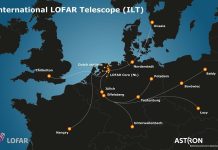
Astronomers may have uncovered a mysterious population of ‘hidden’ galaxies that could change how we understand the universe.
If these galaxies are real, they would shake up current theories about how many galaxies exist and how they form and evolve.
Not only could they transform our understanding of galaxy formation, but they might also help solve the puzzle of how the universe produces energy in infrared light.
This groundbreaking discovery was made using data from the Herschel Space Observatory, a European Space Agency mission that operated from 2009 to 2013.
Herschel was designed to observe the universe in infrared light, allowing astronomers to see things hidden from normal telescopes.
During its mission, Herschel’s SPIRE instrument captured images of the same ‘dark sky’ patch every month for calibration purposes. What they found was far more interesting than expected.
To dig deeper, researchers from STFC RAL Space and Imperial College London combined 141 of these images, a process known as ‘stacking.’ This technique allowed them to spot fainter objects by adding up the light from multiple images.
The result was the Herschel-SPIRE Dark Field—the deepest image ever taken of the far-infrared sky, revealing nearly 2,000 distant galaxies. Many of these galaxies are incredibly faint and dusty, which makes them nearly invisible to regular telescopes.
In infrared light, however, their glow is visible. Astronomers believe these hidden galaxies could be a major source of the universe’s energy in infrared light, potentially filling a major gap in our understanding.
The image was so deep and captured so many galaxies that some of them blurred together, making it difficult to tell them apart. To solve this, Thomas Varnish, a PhD student at MIT, used statistical methods to analyze the blurry sections.
His research suggested that there may be even more galaxies hidden in the background, too faint to detect with conventional methods. If proven true, these galaxies would force scientists to rethink how the universe evolved.
The next step is to confirm their existence with new telescopes that can observe at different wavelengths.
One promising project is PRIMA, a proposed next-generation far-infrared telescope that could finally reveal these hidden galaxies in detail. If successful, PRIMA could be a game-changer in understanding the universe’s most elusive secrets.



